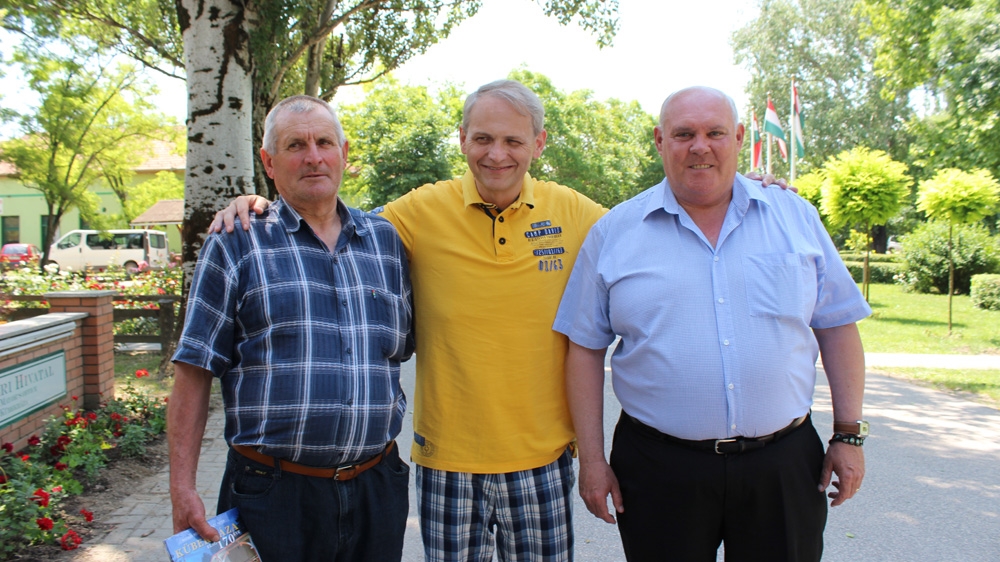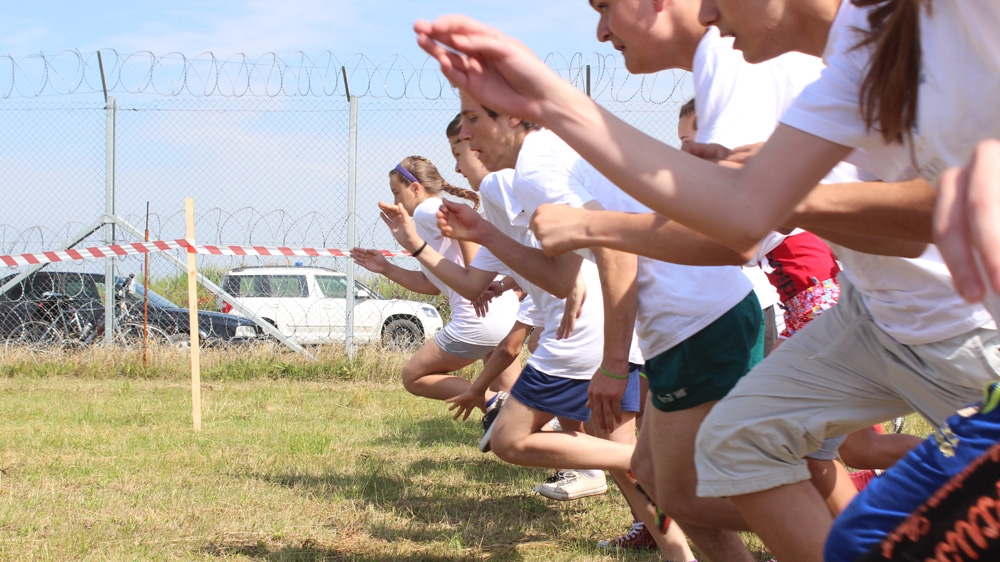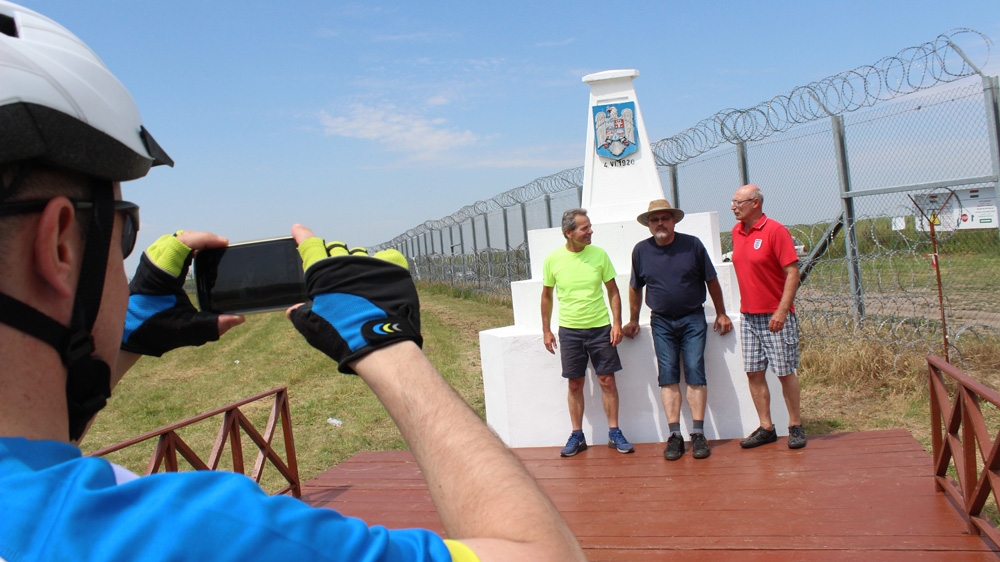Hungary: Three villages and the fence that divides them
Residents of villages on the Hungary-Romania-Serbia border maintain close ties despite the fence between them.

Kubekhaza, Hungary – A Roman ian brass band plays Ode to Joy under the shadow of a tall fence that runs along the Hungarian border at the point where it meets Serbia and Romania. Locals and officials from the three countries are gathered for the annual “border opening” ceremony. The villages of Kubekhaza in Hun gary, Beba Veche in Romania, and Rabe in Serbia have been separate entities since 1920, but residents seem eager to maintain ties with one another.
Each year since 1997 , a ceremony organised by the Danube-Kris-Mures-Tisa (DKMT) euroregion has been held at the point where the three countries meet.
The borders are opened for two days at the end of May, allowing residents to reach relatives living across country lines. It’s not uncommon for villagers to cross over to eat out in Rabe or to visit a zoo in the nearby Hungarian city of Szeged at any time of year. But t he border-opening ceremony serves as a symbol of the bond between the villages.
Until last September, the tripoint was an invisible border with a simple triangle-shaped statue approximately one kilometre away from each village. But, today, a four-metre wire fence along the Hungary-Serbia border – built to keep out migrants and refugees – snakes across the once open fields.
|
|
Still, the opening ceremony goes ahead as usual. After anthems and speeches, the festivities begin.
One part of the ceremony that has been directly affected by the fence is the children’s race. As they are no longer able to run unobstructed around the tripoint statue, it has been moved to Serbian territory.
Officials from each country – Branislav Bugarski, the secretary for interregional cooperation and local self-government of Vojvodina; Titu Bojin, the president of the Timis county council in Romania; and Bela Kakas, the president of the Csongrad county council in Hungary – open the border.
Some people cross, presenting their identification documents to the border police, to visit relatives living on the other side.
Aranka, 64, from the Serbian side, is the first to make the trip that day.
“I’m going to visit my mother, as I’m from Kubekhaza, Hungary,” she says. “I married a man from Banatsko Arandjelovo, Serbia, 45 years ago, and I have lived there since our wedding.”
Her normal route through the official border crossing is 50km long. But today she rides her old bike for the 10km journey through the tripont.
Beba Veche and Kubekhaza are only kilometres apart, but to cross the border, residents usually have to travel 78km – a 75-minute car journey.
Ivan, a pensioner and enthusiastic cyclist from Subotica, Serbia, uses the open border to tour around the region along a path which starts and ends at his hometown . He believes that the fence exists for political reasons but changes nothing for the locals.
WATCH: No Refuge – Children at the border
“This fence is not here because of us,” says Szilvia Domokos, who lives in Rabe.
She says she sometimes encounters small groups of refugees in her village and tries to explain to them that it is easier to reach the end of the fence and cross into Hungary from there. They don’t want to pass through Romania, she explains, because they fear the Romanian border police.
“The refugees steal our ladders instead,” she says, noting that they consider it less risky to take a ladder to climb the fence in Rabe than to walk around it and step into Romania.
 |
| Mayors of the villages – Peter Makra of Rabe, left, Robert Molnar of Kubekhaza, centre, and Ioan Bohancanu of Beba Veche – believe the fence is a barrier between villagers [Balint Bardi/Al Jazeera] |
‘The fence does not belong in modern Europe’
Kubekhaza in Hungary is one of the most rapidly developing villages in the region. Its mayor, Robert Molnar, had opposed the building of the fence.
“I will never forget [that day],” he says. “In the summer, a journalist called me to comment on the fence near Kubekhaza. ‘Which fence?’ I asked. Nobody from the government asked my opinion before the construction.”
But Verica Vas, the secretary of the office of Rabe’s mayor, Peter Makra, told Al Jazeera: “We [in Serbia] understand that the Hungarian prime minister wants to defend his country this way.”
In September, Hungary completed the fence along the Serbian border, stretching from the tripoint to the Croatian border. The Hungarian prime minister, Viktor Orban, announced that another fence would be built along the Romanian border if the Balkan route alters and migrants try to approach Hungary from Romania.
READ MORE: Refugee centres fill up as Hungary tightens borders
While many Serbian locals seem content with having a fence on their northern border, most residents of Beba Veche in Romania oppose it.
Beba Veche is a smaller village, inhabited by Romanians and Hungarians, many of whom work in factories farm their own land or work for agricultural companies.
“If we are good neighbours, we don’t build up a [large] wall between us,” says Janos Uzson, a Beba Veche resident and the village’s accountant.
Uzson adds that “residents know that Hungary built the fence because of the migrants. If they didn’t have this migration issue, they wouldn’t need the fence”.
Still, he says the fence is a symbolic barrier between the villages and a restriction that is reminiscent of communist times.
Branislav Bugarski, the secretary for interregional cooperation and local self-government of Vojvodina in Serbia, agrees. “I think the fence does not belong in modern Europe,” he says. “What Europe needs are common solutions and policies for the future, not fences.”
A history of migration
“We are used to the impact of migration,” explains Robert Molnar, the mayor of Kubekhaza.
Indeed, the three villages have been affected by migration since the middle of the 20th century, when political refugees fleeing Romania’s Ceausescu regime crossed the border here.
A little later on, men fleeing military conscription during the Balkan wars would pass through, sometimes bringing their families with them.
 |
| The annual race where children from the three countries run around the statue of the tripoint. This year, despite a changed route, the enthusiasm remained [Balint Bardi/Al Jazeera] |
As the tripoint is not on the refugees’ main route, only the residents of Rabe occasionally encounter them. One day last April, 250 refugees arrived in Rabe on busses.
“We are 80-90 people in the village, so when 250 strangers come … we are afraid,” says Makra, the mayor of Rabe. His phone rang all night long, he says, as the residents didn’t know how to respond to the refugees who were knocking on their doors, asking for water or to charge their phones.
Plans for the future
The three villages have planned collaborative projects since the 1990s – although nothing has emerged except the border opening ceremony. Now, the three mayors agree that the fence only decreases the likelihood of them carrying out their plans.
The most promising is an unfinished official border crossing station near the tripoint that could allow people to travel between all three countries. The villages have recently handed in a joint declaration of intent to their homeland authorities expressing their desire to build it. But Molnar, the mayor of Kubekhaza, doubts it will go ahead.
In his opinion, as long as the Romanian-Hungarian diplomatic relationship is tense due to separate ethnic disputes, it will not be possible to open a border-crossing between the two countries.
In contrast, the Hungarian-Serbian diplomatic relationship seems stable. The two countries had opened a border crossing station on the main route for refugees last year at the height of the refugee crisis.
This cooperation has made Makra, the mayor of Rabe, more confident. He believes the border crossing station could be opened by 2020.
READ MORE`: Hungary’s border war on refugees
Another plan that is in the works is a business park with factories, hotels, and conference halls near the tripoint – a joint project between Beba Veche and Kubekhaza.
An impact study has already been conducted by the Romanians, and foreign investors from China have shown interest in the project. But Uzson, Beba Veche’s accountant, however, remains sceptical.
“The business park would be great, but the world will not collapse without it,” he says. “We did our part, now we wait and hope.”
 |
| The flat, open region near the tripoint is popular destination for cyclists, who explore new routes when the borders open [Balint Bardi/Al Jazeera] |
Follow Balint Bardi on Twitter @balintbardi